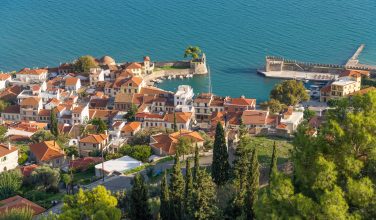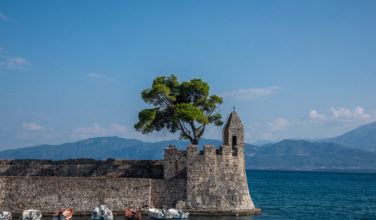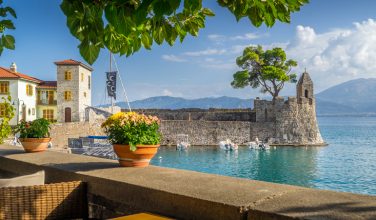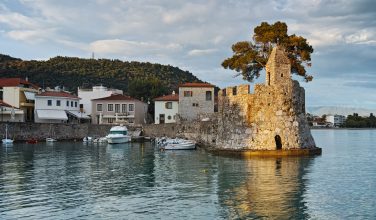Nafpaktos is a town in Phokis, Greece. Nafpaktos is a small seaside town on the southern coast of Sterea. The town of Nafpaktos was built 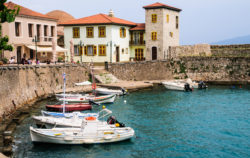 amphitheatrically on the slopes of the hill around a small port. On a hill above the town sits a Venetian castle. Pine forests surround the town.
amphitheatrically on the slopes of the hill around a small port. On a hill above the town sits a Venetian castle. Pine forests surround the town.
The statue of Nike was a dedication of the Nafpaktians and the Messenians after their victory of the Spartans in 421 BC. Sculpted by Paionios of Mendi, the statue is considered a masterpiece of ancient Greek sculpture. The statue stands 10.92 meters tall and represents that winged goddess Nike. It looks as if she is coming down off Mount Olympus to announce the victory. This was the first time in the history of Greek sculpture that flying wings were depicted. Sadly, the wings as well as the face and cape of the statue were destroyed. The statue was uncovered in 1875 and is now in the Olympia Museum.
During the 15th century, when Nafpaktos was ruled by the Venetians, it would be known as Leptano. In 1499, the town fell to the Ottoman Empire and was used as their naval station. It would be the site of a victory by the Holy League in the Battle of Leptano in 1571. The town would remain under Ottoman control, except for a brief period of Venetian control from 1687 – 1699. The Venetian Morozini, along with Austrian allies, took Nafpaktos and turned the town over to the Venetians. Then the town of Nafpaktos was given back to the Turks under the Treaty of Karlowitz and would be enslaved until 1829. The Greek Revolution broke out in 1821 and by 1829, Turks and Albanians were no longer able to withstand the siege and surrendered Nafpaktos to the Greek state.
Administrative Region of Nafpaktos, Greece
West Greece
Area of Nafpaktos, Greece
159.9 km2 (61.7 sq mi)
Population of Nafpaktos, Greece
Municipal Unit: 19,768
Community: 31,594
Top Attractions in Nafpaktos, Greece
Statue of Cervantes – Located at the port of Nafpaktos. This statue is dedicated to the great Spanish writer who fought in the Battle of Leptano. The battle took place in 1571 and Miguel de Cervantes would lose his left arm.
Venetian Castle – Located on a hill above the town. This is a well-preserved castle and one of the most beautiful in all of Greece. The castle, with its five defensive walls, protected Nafpaktos during wars.
Tower of Botsaris – Located near the central square of Nafpaktos, close to the Venetian Castle. It is actually two towers, one constructed in the 15th century by the Venetians and the other in the 16th century by the Turks. There is a permanent exhibition of the Battle of Leptano on the ground floor.
Town Beach – Located in front of the city center, so there are amenities nearby. The port of Nafpaktos divides the beach into two: the beach of Psani to the west and the beach of Gribovo to the east. Both beaches have been awarded the Blue Flag and have facilities available.
Statue of Anemogiannis – Located near the Nafpaktos port. Anemogiannis was part of the fight to liberate Greece from the Turks. He died a hero in May of 1821 during a failed attempt to burn the Turkish fleet.
Platanitis Beach – 9 km west of Nafpaktos. This is a family friendly beach that is partly organized and features crystal clear waters. Platanitis Beach offers a view of the Rio-Antirrio Bridge.
Church of Prophet Elias – Located inside the Castle of Nafpaktos.This churh is small with a white cross painted on the front wall. A picturesque little church worth stopping to see.


